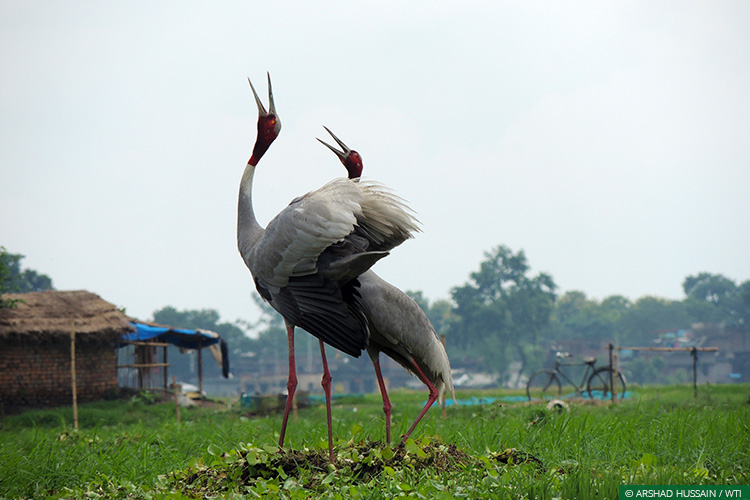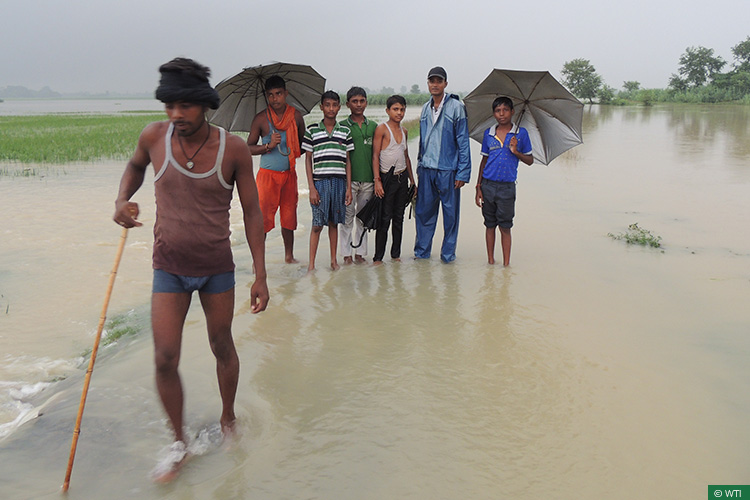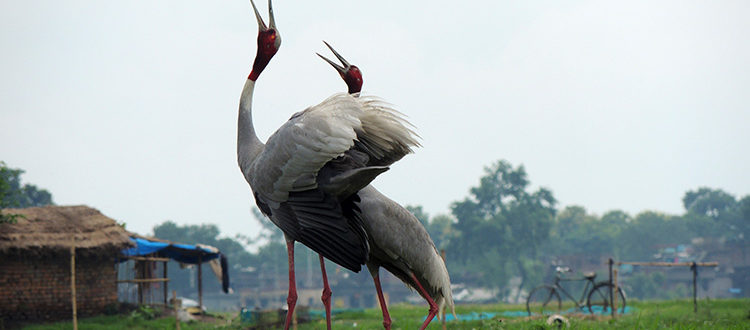Sarus Cranes Suffer in Floods in Eastern Uttar Pradesh
 File Photo: A pair of courting sarus cranes near their nest by a wetland in the Maharjganj district of eastern UP
File Photo: A pair of courting sarus cranes near their nest by a wetland in the Maharjganj district of eastern UP
Maharajganj, Uttar Pradesh, September 18, 2017: A steep rise in the water levels of rivers flowing through the eastern Uttar Pradesh (UP) landscape caused severe floods in more than 20 districts of the state last month. The second and third week of August witnessed heavy rainfall in the catchments of the Sharda, Gaghra, Gandak, Rapti, Rohin, Kakrahi, Quano, Chandan, Pyas and other rivers, disrupting the lives of millions of people and causing huge losses to standing crops and property.
Floods in the region not only affected the human population but also the sarus crane, which is the state bird. The sarus’ nesting season coincides with the monsoon and the floods destroyed most of the nests in the wetlands and rice paddies. In Maharajganj, the worst-affected district, peak floodwaters were reportedly flowing two to three feet above the major highways. “The flood level was enough to damage 30 to 40% of about five dozen sarus nests that we had recorded in the district”, said Arshad Hussain, Senior Officer with Wildlife Trust of India’s (WTI) Sarus Crane Conservation Project. Apart from Maharajganj, the stronghold of the sarus in eastern UP, floods also affected 30 nests in the Kushinagar and Siddharth Nagar districts, Arshad reported. Most of the affected nests had eggs that were close to hatching.
“Our initiative to conserve and use wetlands wisely will, in the long-term, help reduce the effects of floods in the landscape besides helping the sarus crane”, said WTI’s Dr Samir Sinha.
Wetland ecosystems act as flood moderators but encroachments and changes in land use have caused their shrinkage throughout the country. Wildlife Trust of India’s project, which is funded by Tata Trusts, covers ten districts in eastern UP – Bahraich, Shravasti, Balrampur, Siddharth Nagar, Maharajganj, Kushinagar, Deoria, Pratapgarh, Barabanki and Faizabad – where wetlands cover an area of over 2200 sq km. The project focuses on protecting the sarus crane as well as conserving wetlands, key habitats of the species, with the involvement of farmers, fishers and other local communities.
“To protect sarus nests on farmlands and wetlands we have sensitised local farmers, who have saved around 300 nests since 2014. This has resulted in a significant increase in the sarus population in the ten project districts, from around 700 in 2013 to 1800 in 2017”, said Dr Samir Sinha, Head of WTI’s Species Recovery Division.
“Our initiative to conserve and use wetlands wisely will, in the long-term, help reduce the effects of floods in the landscape besides helping the species”, Dr Sinha added. WTI has identified 30 wetland areas important for sarus crane conservation in the region.
 Baiduli Taal, a wetland in Maharanjganj, during the monsoon floods
Baiduli Taal, a wetland in Maharanjganj, during the monsoon floods









